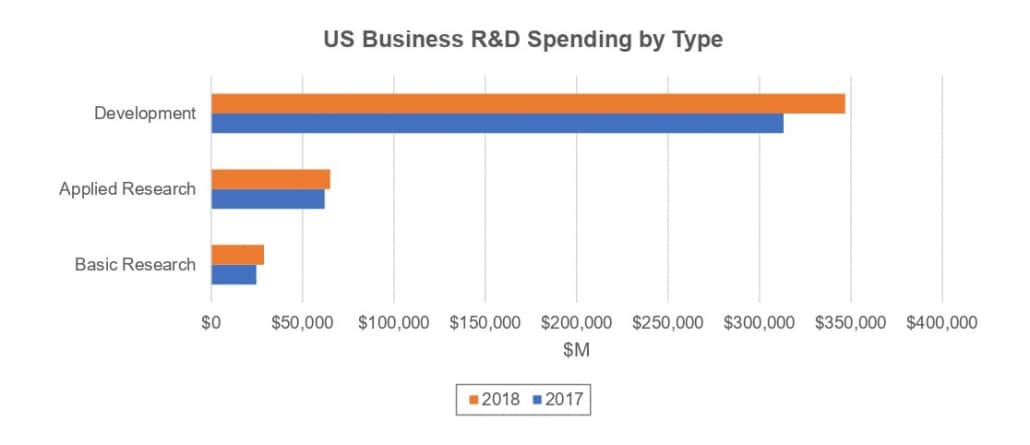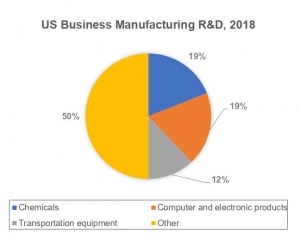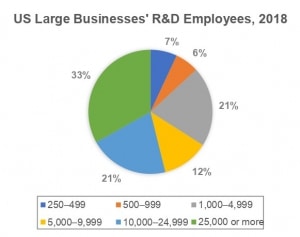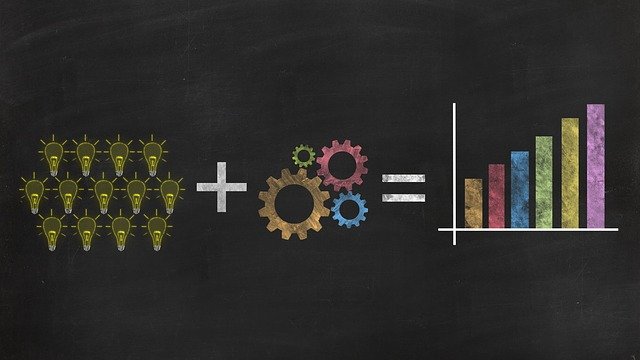US Business R&D Tops $440 Billion in 2018
Published this month, the National Science Foundation’s (NSF’s) review of US business R&D spending in 2018 indicates the robust contribution of business R&D to the economy and the diversity of industries conducting R&D in the US. It also lays out the importance of both manufacturing and non-manufacturing R&D to innovation.
Top Spending
Total US businesses’ R&D expenditures grew 10.2% in 2018 to $441,036 million. Eighty-six percent of all research was performed by business itself. Nearly 80% of the R&D was for development. In addition, businesses with over 250,000 employees performed 89% of R&D. R&D as a percentage of sales for all industries was 4.1%.

Source: NSF
Top Industries
Of the two categories of businesses (manufacturing industries and non-manufacturing industries), manufacturing industries funded 62% of 2018 US business R&D. Within manufacturing, this was led by the chemical industry, which spent $84,137 million on R&D in 2018, just barely surpassing the computer and electronic industry’s total of $83,697 million.
Eighty-seven percent of chemical R&D was self-funded, on par with the 86% self-funded by US manufacturing industries combined. Within the chemical industry, pharmaceuticals had the highest ratio of R&D to sales among all manufacturing businesses at 11.4% due to total R&D spending of $74,592 million.

Source: NSF
For non-manufacturing, 2018 R&D spending was led by the information industry, which contributed $93,349 million, or 21% of manufacturing and non-manufacturing industries’ R&D spending combined. It was also a non-manufacturing sector, scientific research and development services, that led both manufacturing and non-manufacturing industries with the highest percentage of R&D per sales (R&D ratio) at 28%. For all non-manufacturing business, the R&D ratio stood at 3.5%. For manufacturing, the R&D ratio was 4.6%.
Government’s Role
Government funding played a more fundamental role in some sectors. In 2018, the aerospace products and parts industry self-funded 46% of R&D, the lowest percentage among all industries tracked. Making up the difference was the federal government, contributing 50% to this industry’s total R&D expenditures. This situation was similar for professional, scientific, and technical services, for which 50% of industry R&D was paid for by business itself in 2018, but 25% was paid for by the federal government. Overall, government funding contributed 6% to all US businesses’ R&D in 2018.
R&D Employment

Source: NSF
Fifty-six percent of the 1.8 million business R&D employees worked in manufacturing industries in 2018. The highest percentage,16%, of combined manufacturing and non-manufacturing employees worked at computer and electronic product businesses. The highest percentage of R&D workers among non-manufacturing industries, which together employ 44% of manufacturing and non-manufacturing employees, are employed by the information sector at 19%.
Instrument Business Outlook (IBO), a subscription-based newsletter covering the scientific instrument industry, is a regular source of information about scientific R&D spending. For information on IBO, please click here.





